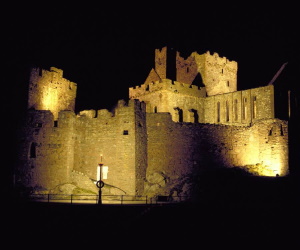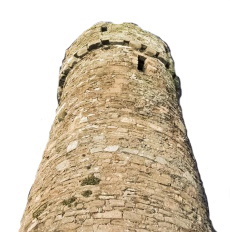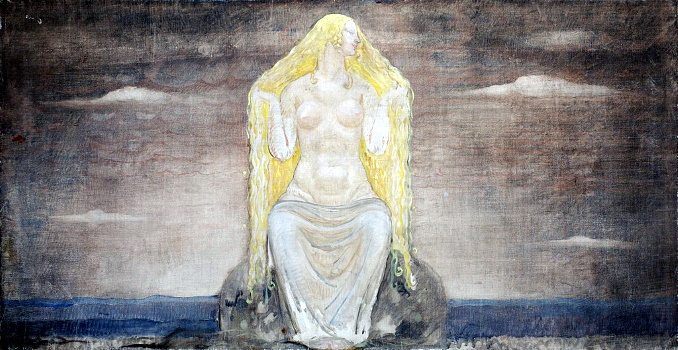Manx Castle Haunted By The Phantom Hound "Moddey Dhoo"

Throughout the Celtic lands there are many stories of ghosts. Usually the disembodied soul or spirit of a person, but these tales of the unexpected can also be about various other animals. One of which is that of the Moddey Dhoo which is the Manx Gaelic name for Black Dog. A phantom black hound that reputedly haunts the ruins of Peel Castle (Manx: Cashtal Purt ny h-Inshey) on the west coast of the Isle of Man (Manx: Mannin). One famous story about the Moddey Dhoo involved the soldiers who in the past were responsible for guarding and securing the castle.

Even in those days the Moddey Dhoo was known about and feared and the soldiers would always travel in pairs to safeguard against the dreaded hound. However, one night, in 1666, a soldier emboldened by the false courage of alcohol, decided to undertake the task on his own. He ridiculed the concerns of his colleagues who pleaded with him not to go alone. The other soldiers became increasingly concerned when he failed to return.
Eventually, they heard blood curdling screams but were too frightened to come to the aid of their stricken comrade. They knew it was the fearsome Moddey Dhoo ghost dog that had the soldier at his mercy. After a short time the door burst open and the lone soldier who now stood before them was almost unrecognisable. His look of terror spoke volumes. His eyes wide with terror, his face a deathly pallor. His clothes were ripped to shreds and he was covered in blood. He did not say anything of his experience and sat silently in front of the fire. There he remained, not moving or speaking. Three days later he died.
Some say the Moddey Dhoo still roams the grounds and hidden passages of Peel Castle. However, don’t let that put you off visiting this attractive and substantially preserved historical castle. It stands on St Patrick’s Isle (Manx: Ellan Noo Perick), a small island off the west coast of the Isle of Man next to the town of Peel (Manx: Purt ny h-Inshey). Archeological studies have revealed permanent occupation on the site dating to the Late Bronze Age. The Isle of Man's first known human inhabitants, were the hunter-gathering people of the Middle Stone Age.

It is to Patrick’s Isle where some say St Patrick first set foot in the Isle of Man in 444 AD when on his way to Ireland. He is then said to have appointed the Celtic missionary St German who lived from approximately 410 AD to 474 AD and oversaw further development of the Church on the Isle of Man. On the site of the Castle the remains of buildings belonging to the Celtic monastery, possibly dating from the 6-8th centuries can be seen. Dominating these remains stands the Irish style round tower; early medieval stone towers of a type found mainly in Ireland. Only three original such towers exist outside of Ireland; this one and two in Scotland.

The first known fortification on St Patrick’s Isle came after the arrival in 1098 of the Viking chieftain Magnus Olafsson (Old Norse: Magnús Óláfsson), better known as Magnus Barefoot who was King Magnus III of Norway from 1093 until his death in 1103 and also King of Mann and the Isles from 1099 to 1103. He was called Magnus Barefoot/Barelegs due his adoption of Gaelic type clothing leaving the legs bare. Magnus campaigned around the Irish Sea from 1098 to 1099. The medieval Chronicles of the Kings of Mann and the Isles tell us that he saw to the erection of two wooden prefabricated forts, one now believed to be in the South of the Isle of Man and the other on St Patrick’s Isle. Other buildings still visible on the Isle are the 13th century cathedral of St German and later buildings allied to it, as well as medieval armory and barracks. These are protected by fortifications consisting of 14th century flanking towers, linked by 15th century curtain walls. More recent military construction took place in the early 19th century during the Napoleonic wars and later in the 1860s during the time of Napoleon III.
There has been a history of burials on St Patrick's Isle over many centuries, both before and after the Viking Age. Excavations in the 1980's led to the discovery of pagan graves from the Viking period. One of them was of a female, buried at around 950 AD. She was buried with a number of items that have resulted in it being considered to be the richest Viking Age female burial in the British and Irish Isles and outside of Scandinavia. She has become known as The Pagan Lady of Peel. The woman was buried with a fine and rare necklace made up of 73 glass beads sculptured from stones from over a wide area of Europe and the Middle east.

There were also a number of mysterious items and various charms buried with her. Including two pieces of stone which looked like a tiny pestle and mortar and she also had a long iron rod down by her side. An iron cooking spit had been placed by her side. It had been wrapped in woollen cloth. Goose feathers were found on the spit. Other items buried with her included knives, a pair of shears used for cutting cloth, and a leather and bronze pouch. It is clear that this is a grave of a wealthy woman, but the range of other items found with her suggest that this could also be the final resting ground for a wise woman. Among the Vikings they were called Volva, a pagan sorceress. A woman that would have dispensed advice and could have been seen by her local community as having special powers.
Further Reading
Mysterious Remains Of The Pagan Lady Found In A Manx Castle
Content type:
- Manx
Language:
- English






